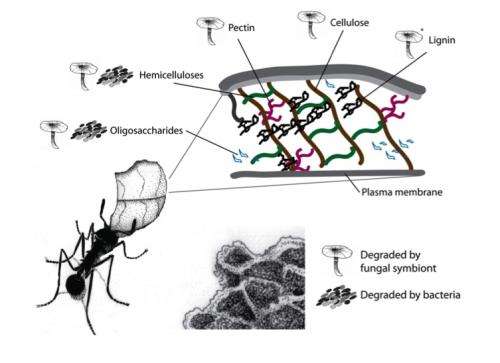Plant polymer degradation in the leaf-cutter ant gardens: the fungus, Leucoagaricus gongylophorus, plays a dominant role in breaking down cellulose, lignin, and pectin. The bacterial community and the fungus break down simple oligosaccharides and hemicelluloses. Credit: FO Aylward
(Phys.org) —A multi-institutional team from the Department of Energy's Great Lakes Bioenergy Research Center (GLBRC) used metagenomic and metaproteomic approaches to provide insight into the symbiotic relationship between leaf-cutter ants, fungi, and bacteria. In doing so, they have mapped the first draft genome of the predominant fungus and clarified its role in lignocellulose degradation in underground fungal gardens tended by the ants. Ultimately, scientists hope that this understanding will help the development of cellulosic biofuels.
The research goal was to characterize whether bacteria or fungi drive lignocellulose degradation in these underground gardens where the ants bring leaf pieces to cultivate microbes as food sources. The fungus Leucoagaricus gongylophorus, traditionally thought of as the ants' food, grows from the leaves. Results indicate that L. gongylophorus plays a dominant role in breaking down cellulose so bacteria can further transform the partially digested sugars into a variety of nutrients that could promote the fungi's growth and even nourish the ants themselves. When it comes to biomass conversion in leaf-cutter ant gardens, it's apparent that neither fungi nor bacteria work in isolation.
Leaf-cutter ants are hallmark examples of insect herbivores that gain access to nutrients in plant material through symbiosis with microbes. The fungal gardens tended by these ants allow them to convert plant biomass on a very large scale. But just how they do this is poorly understood. Given the growing interest in cellulosic biofuels, understanding how large-scale and rapid plant biomass degradation occurs among highly evolved insect herbivores is particularly relevant for bio-inspired approaches to plant biomass conversion. Researchers are looking at the microbial composition of the fungal gardens to learn more about the process by which the leaves are decomposed and cellulose is degraded.
The team performed metagenomics and metaproteomics analyses of L. gongylophorus isolated from the gardens of two leaf-cutter ant species, Acromyrmex echinatior and Atta cephalotes. Though the natural gardens are located in Gamboa, Panama, the researchers studied material from colonies reared in the laboratory on diets of oak (Quercus) and maple (Acer) leaves. From the metaproteomic analyses, 44,347 mass spectra were mapped to all L. gongylophorus lignocellulases (pectinases, xylanases, amylases, and cellulases).
Next, the team plans to characterize how these lignocellulases in leaf-cutter ant gardens respond to changes in the substrate that the ants incorporate into the gardens.
More information: Aylward, F. et al. 2013. Leucoagaricus gongylophorus Produces a Diversity of Enzymes for Recalcitrant Plant Polymer Degradation in Leaf-Cutter Ant Fungus Gardens. Applied and Environmental Microbiology (published ahead of print 12 April 2013) DOI: 10.1128/AEM.03833-12.
Journal information: Applied and Environmental Microbiology
Provided by Pacific Northwest National Laboratory























